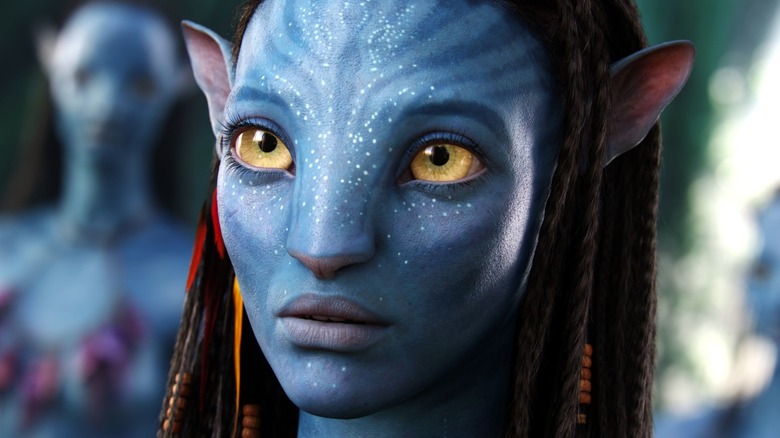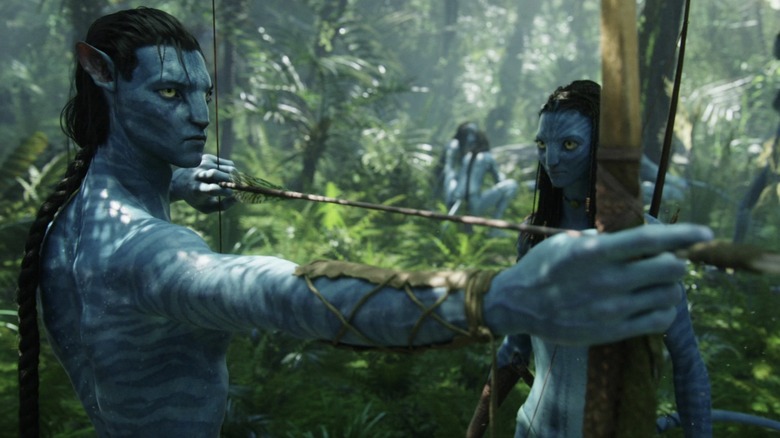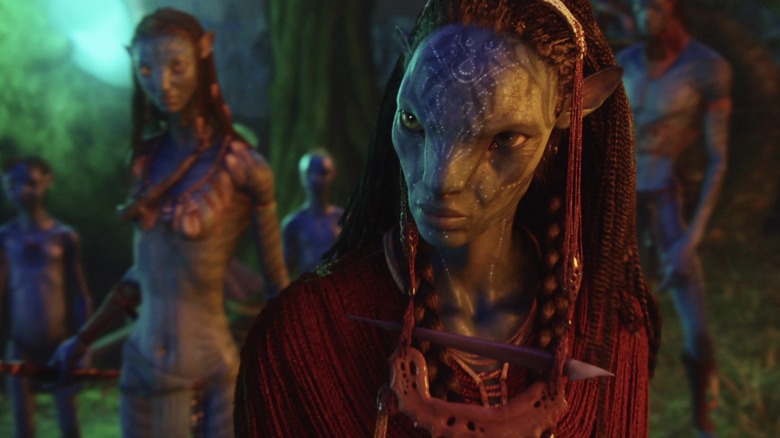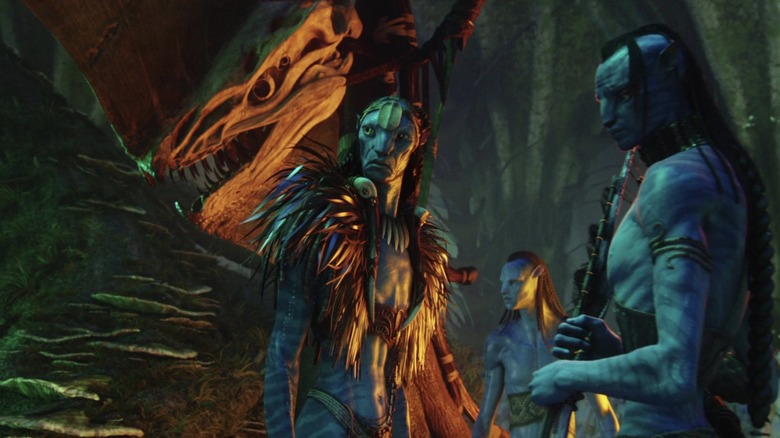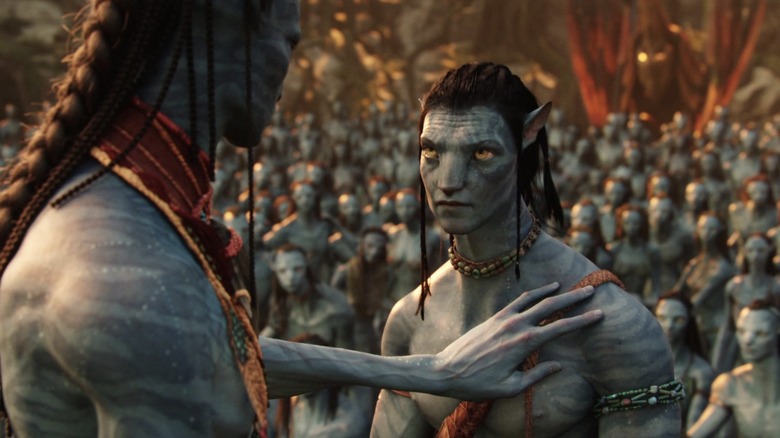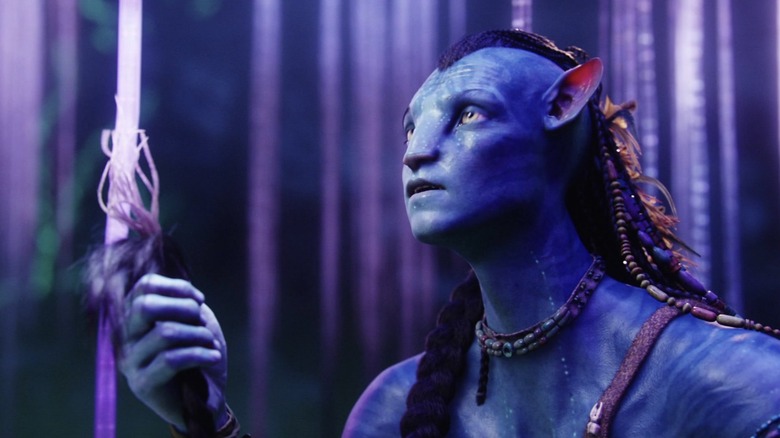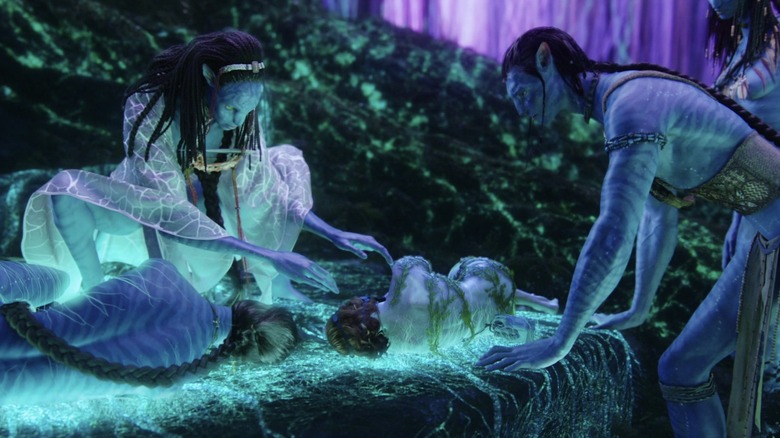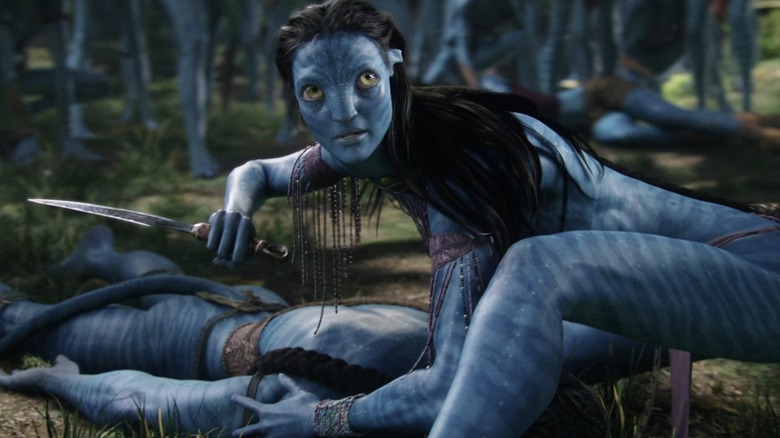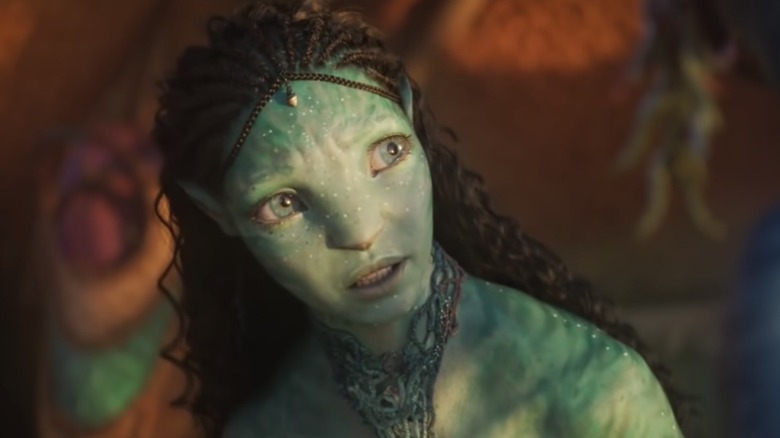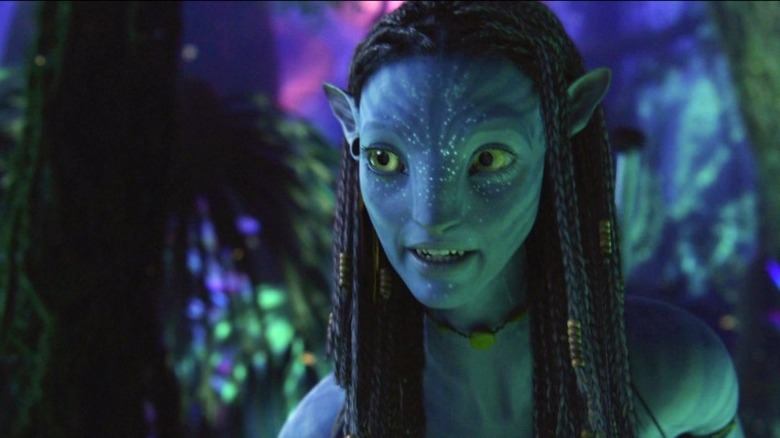The Untold Truth Of The Na'vi From Avatar
With "Avatar: The Way of Water" coming out in December 2022, you've probably been thinking about rewatching "Avatar" and looking forward to visiting Pandora again. In 2009, James Cameron described "Avatar" as an adventure story, telling Entertainment Weekly, "I've always had a fondness for those kind of science fiction/adventure stories, the male warrior in an exotic, alien land, overcoming physical challenges and confronting the fears of difference. Do we conquer? Exploit? Integrate? 'Avatar' explores those issues."
While "Avatar" might start with an outsider exploring a new world and the aliens who inhabit it, the story soon becomes one about a man who not only falls in love with a stranger but falls in love with her culture and planet. Cameron's groundbreaking film is about having contact with another culture and how this contact profoundly changes your outlook on life, love, and spirituality. "Avatar" is about traveling to a strange land only to discover that it feels like home and that you will do anything to protect it.
The conflict between aliens and invaders, Pandora, and the Na'vi people has been bouncing around Cameron's mind since the 1970s. Because of this drawn-out incubation period, Cameron created an entire world filled with unfamiliar animal and plant species that dazzle on the screen. He also created a new species of humanoid aliens to capture our imaginations. Considering the time, thought, and effort that went into creating the Na'vi people and their culture, not everything made it into "Avatar." Keep reading as we explore the untold truth of the Na'vi.
The Na'vi were inspired by a dream James Cameron's mother had
A dream his mother had in the 1970s about 12-foot-tall blue aliens inspired James Cameron's vision of the Na'vi. He told the SF Gate, "My mother said, 'I had this dream about a 12-foot-tall blue woman.' And I thought, that's kind of a cool image." These people from Cameron's mother's dream were first used in a science fiction screenplay he was writing in the '70s but never produced. Cameron said that while brainstorming "Avatar," he returned to these beautiful blue creatures.
After being sued, Cameron wrote a 45-page sworn declaration detailing the various past projects Cameron drew from to create Pandora, the Na'vi people, and their conflict in "Avatar," defending himself against those who claimed he used their ideas. Cameron said, "In or about 1979, I did a large painting which shows a tall, thin woman with blue skin... These tall, slender, blue-skinned, and genetically engineered characters became the basis for the appearance of the indigenous people, the Na'vi, and the genetically engineered avatars in [the film]."
Of course, there were other elements that influenced Cameron's vision for the Na'vi. Cameron told Entertainment Weekly, "I just like blue. It's a good color. [...] Plus, there's a connection to the Hindu deities, which I like conceptually." Considering the title of the film, "Avatar," Cameron was obviously referencing avatars from the Hindu faith, telling Time, "It's an incarnation of one of the Hindu gods taking a flesh form," confirming this film is concerned with spiritual questions.
The Na'vi originally looked much more alien
Originally, the Na'vi had a more amphibian or reptilian look, as James Cameron shared in a documentary about the making of "Avatar." Cameron and his team changed direction constantly during preproduction so the aliens wouldn't repulse the audience, giving them more graceful feline features and ferretlike faces. Because "Avatar" is a love and assimilation story where Jake Sully (Sam Worthington) falls for Neytiri (Zoe Saldana) and becomes one of the Na'vi, the character designers made the Na'vi humanoid and exotically beautiful. In the documentary, Cameron said, "I wanted people to say, 'I want to be one of them.'"
Cameron told Gizmodo, "It was a fine line to walk, between making them too alien. [...] We just kept asking ourselves — basically, the crude version is: 'Well, would you wanna do it?' And our all-male crew of artists would basically say, 'Nope, take the gills out.'" Cameron said that they emphasized the alien and the animal a bit more in the older Na'vi characters to make meeting the future in-laws frightening for Jake.
In an interview with Playboy, Cameron explained how he designed Neytiri to appeal to his male audience's id, sharing how he was drawn to fictional female characters as a young man. He explained how Vampirella sparked lust in him as a young man, saying, "The fact she didn't exist didn't bother me because we have these quintessential female images in our mind, and in the case of the male mind, they're grossly distorted," suggesting he didn't think men would be repulsed by the Na'vi.
The filmmakers took inspiration from indigenous tribes to create Na'vi culture
Writer-director James Cameron told the SF Gate "Avatar" is about imperialism and how more technologically advanced cultures dominate and control native peoples to exploit their natural resources. Because of these themes, existing indigenous tribes inspired the Na'vi. James Cameron told The New York Times, "My perception of the film is that the N'avi represent that sort of aspirational part of ourselves that wants to be better, that wants to respect nature."
Designer Craig Shoji told Gizmodo, "Inspiration came from many sources, but a lot involved looking at current indigenous people of the world including those inhabiting the rain forest like the Penan tribe, and the Kayapo and Yanomami Indians. Also the different tribes in Africa like the Himba, Masai, and Samburu." It wasn't just the way the Na'vi dress or their war paint that was inspired by tribal designs. Their culture and religion were also based upon indigenous tribes.
The Na'vi's connection to nature was borrowed from native cultures that coexist with their environment. Davi Kopenawa Yanomami told Survival, "My Yanomami people have always lived in peace with the forest. Our ancestors taught us to understand our land and animals. We have used this knowledge carefully, for our existence depends on it. My Yanomami land was invaded by miners." Like the Yanomami, many native peoples feel that "Avatar" tells their story and that the film's story is a fictional analog for the real-world exploitation of indigenous cultures and resources.
The anatomical differences between avatars and the Na'vi
While the Na'vi have only three fingers and a thumb, the human-Na'vi hybrids, known as avatars, have four fingers and a thumb, keeping their number of digits from their human DNA (per Pandorapedia). The Na'vi also don't have any hair on their brow bone, while the avatars have kept their eyebrows from their human DNA (per Avatar Wiki). You will also notice the Na'vi have larger feline eyes, four times the size of humans, while avatars have smaller eyes that are closer to the proportional size of human eyes (per Pandorapedia).
Avatars have the height and strength of the Na'vi, and both have a prehensile tail. Early in the movie, we learn the Na'vi have naturally occurring carbon fiber reinforcing their bones, making them especially hardy, but some question if this is realistic. Who really cares if it's possible? This is science fiction! The Na'vi and avatars are stronger and larger than humans. The Na'vi people have a longer lifespan than humans, estimated to be 30% longer.
Considering avatars are a new invention in the world of "Avatar," there is no information available about the lifespan of avatars compared to humans or the Na'vi. Both the Na'vi and avatars have bioluminescent skin and markings that change with emotional states, but there is no information about if these fluctuations are something the Na'vi have control over or if the change is involuntary.
The Na'vi can use their queue to sync to more than the animals and plants of Pandora
In the film "Avatar," we see the Na'vi and Jake Sully's avatar "sync" to the plant and animal life on Pandora with their queue, which looks like a long braid but is an extension of their nervous system that can literally connect the Na'vi and avatars to the neural net of Pandora. This is how Na'vi warriors bond with and control their banshees while flying and direhorses while riding.
Designer Craig Shoji told Gizmodo that the process links straight into the brain, like jacking into a network. "The concepts for that came from referencing a lot of different types of cilia and microscopic photos of hair, bugs, plants, etc. It resulted in a very purpose driven cilia for connecting to the Pandoran world. Simple, yet kinda creepy."
As reported by Vulture, in an interview, Zoe Saldana explained how there was a sex scene cut from the film (to keep the PG-13 rating) showing Jake and Neytiri together. Saldana said, "If you sync to your banshee and you're syncing to a tree, why not sync into a person?" Pandorapedia confirms that this is how the Na'vi mate and that the Na'vi mate for life. Much like how the Na'vi bond with their banshees, when two Na'vi connect their queues, they are creating a bond that will last throughout their lives together.
James Cameron tapped USC professor Paul Frommer to make up the Na'vi language
When James Cameron was developing the film, he realized they would need someone to develop the Na'vi language and began reaching out to linguistics departments. When an email reached linguistics professor Paul Frommer at the USC Marshall School of Business, Frommer jumped at the opportunity to design the Na'vi language and began working on it in 2005 after meeting with the director. Cameron told Entertainment Weekly, "I talked with a number of linguistics experts, but he was the one who kind of got the challenge. He said, 'We're going to beat Klingon! We're going to out-Klingon Klingon!'"
Frommer told Unidentified Sound Object, "He wanted a complete language, with a consistent sound system (phonology), word-building rules (morphology), rules for putting words together into phrases and sentences (syntax), and a vocabulary (lexicon) sufficient for the needs of the script. He also wanted the language to be pleasant sounding and appealing to the audience." Pandorapedia tells us while the different clans might speak dialects of Na'vi, they share a common language, "which is uniform on a planetary scale," unlike humans on Earth.
In 2009, while promoting "Avatar," Frommer told NPR, "At this point, I'm pretty much the only one who knows the grammar. [...] Maybe that'll change as time goes on. ... Who knows?" Frommer discussed how Klingon had taken on a life of its own, wondering if that would be the case with Na'vi. He may have been onto something because there is a website devoted to helping people learn the Na'vi language.
The Na'vi believe in reincarnation
From one viewing of "Avatar," we know how important religion is to the Na'vi. It is central to their culture, and there is no distinction between spiritual life and secular life. We see this in the reverence practiced while hunting, when Jake thanks the animal for its sacrifice. The Na'vi see themselves as part of nature, and this is reflected in their religion, which is a pagan blend of pantheism, animism, and monotheism. This brand of spirituality is not uncommon amongst indigenous tribes on Earth.
Eywa is their Mother Goddess, from which all life comes. Although the Na'vi people are part of Eywa, as is everything on Pandora, like children, the Na'vi have free will. According to Pandorapedia, "The Na'vi also believe that all living things have a spiritual counterpart, or animus, which is endlessly recycled into the consciousness of Eywa and then back into living matter." We see this in practice when Mo'at (CCH Pounder) tries to save Dr. Grace Augustine (Sigourney Weaver) by permanently transferring her consciousness to her avatar after Grace is mortally wounded while escaping the human colony, Hell's Gate.
Although this attempt fails, Grace's consciousness is absorbed by Eywa, where Grace's spirit will rest with the ancestors before being reborn. The Na'vi belief in reincarnation has left some of us wondering if Weaver's character Kiri in "Avatar: The Way of Water" is actually the reincarnation of Grace's spirit. Considering the title of the movie "Avatar" and its connection to Hindu gods, this development would make sense.
The Na'vi aren't overly aggressive with one another, but battles between clans aren't unheard of
From Pandorapedia, we learn there are many rituals, such as a challenge, to solve conflict among the Na'vi, both within and between clans. We see a brief display of Na'vi conflict when Tsu'tey (Laz Alonso) attacks Jake after learning Jake and Neytiri mated. Their fight is emotionally charged because Tsu'tey sees Jake not only as a rival for Neytiri's affection but also for the future leadership of the Omaticaya Clan. When Neytiri comes to Jake's aid, it is clear she has made her choice between Tsu'tey and Jake, despite the betrothal. After Jake becomes the sixth Toruk Makto to unite the clans against Colonel Miles Quaritch (Stephen Lang) and the Resources Development Administration, or RDA, Tsu'tey fights by Jake's side and transfers leadership to Jake after heroically dying in battle.
Although the Na'vi people unite in "Avatar," tensions between clans aren't unheard of. When clans are forced into the same territory because of natural disasters like flooding or volcanic eruptions, it isn't unusual for a battle to transpire. According to Pandorapedia, the Na'vi have never experienced a world war, and negotiations follow any skirmish between clans to resolve the conflict quickly.
When asked if the Na'vi have wars, Leri Greer at Weta Workshop told Gizmodo that Weta considered the concept of Na'vi warfare in depth when designing warpaint and war gear. Ultimately, Greer said, Weta concluded that the Na'vi don't conduct warfare anymore, but they "do put a lot of effort into numerous annual gatherings where they 'compete' for their specific tribe's honor and pride."
There are 12 known Na'vi clans on Pandora
We get a glimpse of the clans when Jake and Neytiri travel to drum up support for the battle against Quaritch and the RDA. Reportedly, "Avatar: The Way of Water" will explore the Metkayina Clan and the world of the Pandoran ocean. From Pandorapedia, we learn that the various Na'vi clans are on every continent of Pandora and have experienced evolutionary adaptations to their environments. The Na'vi live everywhere, from the lush rainforest we explored in "Avatar" where the Omaticaya Clan lives, to the desert, forested, and polar regions.
According to the Avatar Wiki, there are at least 12 Na'vi clans on Pandora. The Anurai are artisans who were almost wiped out by humans. The Hulanta are potters and weavers who were displaced from the wetlands by bombings. The Olangi Clan is a horse tribe, seen in "Avatar," while the Kekunan Clan was the first to ride banshees. The Mangkwan Clan is known for accepting outcasts, while the Ni'awve has the distinction of being the oldest clan. The Tipani were the first to make contact with humans, while the Rey'tanu Clan remains hidden in the highlands. The Tawkami Clan is recognized for its knowledge of chemistry, and the Tayrangi — seen at the end of "Avatar" — live by the eastern sea. But there could easily be more clans added with future films and tie-in properties — much of the information on the existing clans comes from licensed "Avatar" video games. According to the film's designers, the distinctions among clans is more than just locality and specialty: "The Weta crew decided there were variations in the way each Na'Vi tribe worshipped Eywa, and very different family structures" (per Gizmodo).
Neytiri had a sister
In "Avatar," we learn Tsu'tey is the fiercest warrior in the Omaticaya Clan and will become the clan leader when Eytukan (Wes Studi) passes away or steps down as Olo'eyktan (clan leader). As is their tradition, the Olo'eyktan marries the Tsahik. As Grace tells Jake, someday Neytiri, who is training with her mother Mo'at to become the Tsahik (spiritual leader) of her clan, is betrothed to Tsu'tey. This is a source of tension in the clan when Jake and Neytiri fall in love and become mated because it goes against the social structure of their clan.
We don't learn this in the film, but in the comic miniseries "Avatar: Tsu'tey's Path" — written by Sherri L. Smith — we discover a backstory that further complicates Neytiri and Tsu'tey's already-complicated relationship. Neytiri had an older sister, Sylwanin, who was Tsu'tey's beloved. Sylwanin was in training as the eldest daughter to become the Tsahik when Mo'at steps down from her role, but when Sylwanin died, Neytiri took her place as the future spiritual leader of the clan and also as Tsu'tey's future mate.
The comic series is told from Tsu'tey's perspective and takes place during the action of "Avatar." This comic elaborates on Tsu'tey's experience of meeting and not trusting Jake and Tsu'tey's becoming the Olo'eyktan after Eytukan's death. The comic fleshes out Tsu'tey's character in ways the film does not — actions he takes with Jake, like embracing him as a fellow Omaticaya warrior and passing leadership of the clan to Jake upon his death, become much less surprising than they were in the film.
